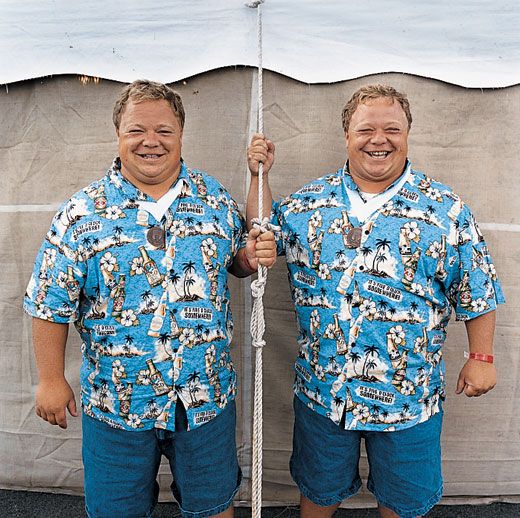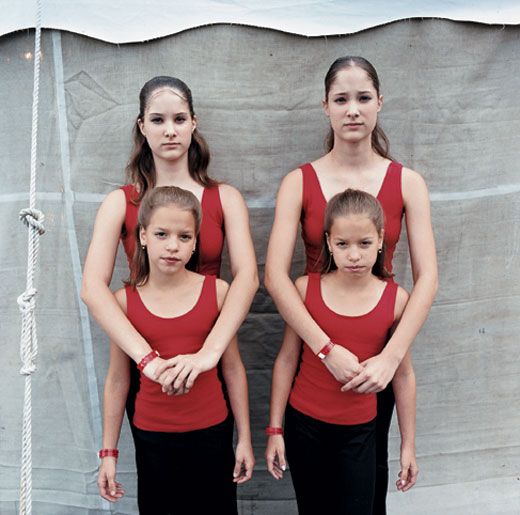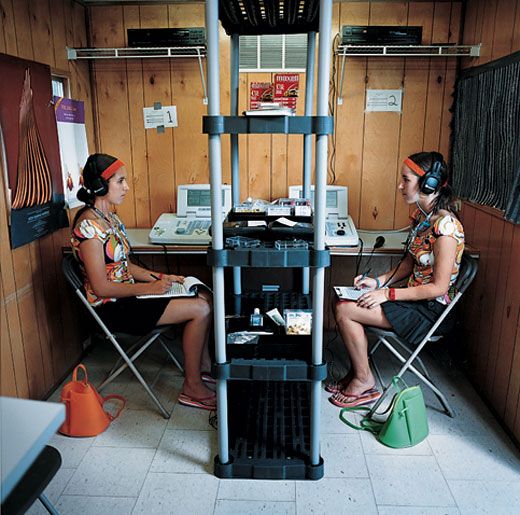Twin Science
Researchers make an annual pilgrimage to Twinsburg, Ohio, to study inherited traits
In 1819, shortly after Moses and Aaron Wilcox arrived in the tiny town of Millsville, Ohio, the identical twins struck a deal with town officials: rename the town Twinsburg in their honor, and they would donate six acres of land for a public square and throw in $20 toward a new school. Moses and Aaron were lifelong business partners, married women who were sisters, had the same number of children, contracted the same fatal disease and died within hours of each other. They were buried in the same grave, one above the other, in Twinsburg's LocustGroveCemetery.
Today, Twinsburg is the site of the Twins Days Festival, the world's largest annual gathering of twins, with some 2,900 pairs attending this past August. Six teams of scientists showed up as well, practitioners of a research tradition that goes back to 1875, when English scientist Sir Francis Galton (Darwin's cousin) studied intelligence in twins. (His insight that twins research can reveal the heritability of certain traits is now widely admired; his enthusiasm for selective breeding to improve the human stock is not.)
Researchers study identical twins—who develop from a single egg that splits after fertilization and therefore have the same genes—to learn how genes influence traits or predispose people to disease. If research finds that identical twins who grew up in the same household (and presumably ate the same foods, went to the same schools and so forth) share a particular trait more strongly than do fraternal twins, who come from two, separately fertilized eggs and whose genes are no more alike than those of any other siblings, it suggests the similarity is due to genes rather than environment. Nature rather than nurture. A shared trait is even more striking if found in twins raised by different families.
Twin studies have shown that shyness, willingness to take risks and propensity toward holding religious beliefs are genetically inherited to some degree, as is the risk of diseases such as osteoporosis, asthma and heart disease. Twin studies have even corrected cruel misconceptions: until a 1995 study confirmed that autism was largely genetic, "a generation of women were taught that they caused the autistic behavior in their children by their distant, aloof parenting," says Robert Morell, a geneticist at the National Institutes of Health in Bethesda, Maryland.
For three years in a row, Morell and co-workers, who study hearing, have journeyed to Twinsburg. At the most recent conclave, they set up shop under a circus-like tent next to five other research teams. One day, twins lined up outside the tent to have their fingerprints taken, their health questioned, their sense of smell and taste examined, and the insides of their cheeks swabbed for DNA.
"There are now nearly 100 genes that are known to cause a malfunction in the ability to perceive sound," Morell said at the festival. When a sound wave travels through the ear canal, it vibrates the eardrum, which vibrates three tiny bones, which vibrate the fluid-filled cochlea. Inside the cochlea, tiny hair cells convert the pulse into an electrical signal to the brain. Morell studies the brain's act of interpreting signals from the cochlea. The brain "performs a very sophisticated processing of those signals, which allows us to identify and understand speech, even when we're also hearing traffic noise, or loud music, or"—Morell gestured to the crowd inside the tent—"a bunch of noisy scientists and twins."
The genetic contribution to such auditory processing is not well understood—and that's where the twins come in. Each participating twin puts on headphones and takes what is called a dichotic listening test. For about 45 minutes, simple words, like "house" and "spent," are transmitted simultaneously, one in each ear. The twins report which words they hear. If there is a genetic component to auditory processing, identicals should score more similarly than fraternal twins do. And if there are auditory processing genes, some researchers suggest, the genes might also contribute to learning and language disabilities. Morell's work is just beginning, but he hopes that identifying auditory processing genes will ultimately help prevent or treat hearing or learning problems in twins and non-twins (singletons) alike.
Also in the tent that day were representatives of the International Association for Identification, a nonprofit group whose members engage in forensic activities. The group was collecting fingerprints and palm prints to confirm that even those of identical twins differ. Other researchers were studying skin diseases, incontinence after giving birth and hair loss. Twins' noses wrinkled at the smell-and-taste study table, where scientists were testing genetic predilections for detecting certain herbal compounds or the bitter quinine in tonic water. A social scientist armed with a stack of surveys was even trying to determine if there is a biological influence on why some people prefer comedies to dramas, hard news to fluff, or, say, are garrulous or quiet.
One motivation for participating in the tests was money: some experiments paid $10 to $15. Other twins were simply curious about their twindom or wanted their DNA to be analyzed to confirm that they were indeed identical or fraternal twins. (Identical twins may vary considerably in appearance, while fraternals can look remarkably alike.) In the end, though, most said they were simply happy to help scientists better understand, or possibly cure, a disease. "I feel so privileged to have been born a twin, the least I can do is help out in this small way," says Stefanie Nybom from Ontario.
Twins, of course, aren't surprised that twin studies turn up an inherited component for many traits. "I think genetics plays a strong role in who we become," says Kathy (Nybom) Bateman, Stefanie's twin, who marched with her sister in the festival's traditional "Double Take" parade. "Obviously, the experiences we have shape us too, but our genetic codes really guide or govern how we react to these experiences, positively or negatively."
Not surprisingly, Stefanie agrees.



